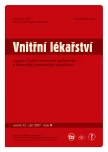Current state of robotically assisted cardiac surgery
Authors:
M. Šetina 1; J. Veselka 2; A. Mokráček 3; I. Vaněk 1
Authors‘ workplace:
Kardiovaskulární centrum pro dospělé, Kardiochirurgické oddělení FN Motol, Praha, přednosta prof. MUDr. Ivan Vaněk, DrSc.
1; Kardiovaskulární centrum pro dospělé, Kardiologické oddělení FN Motol, Praha, přednosta doc. MUDr. Josef Veselka, CSc.
2; Kardiocentrum, Kardiochirurgické oddělení Nemocnice České Budějovice, a. s., přednosta prim. MUDr. Aleš Mokráček, CSc.
3
Published in:
Vnitř Lék 2007; 53(9): 986-989
Category:
Review
Overview
Objective :
The aim of the paper was to describe history, development and current state of robotically assisted cardiac surgery.
Background:
Robotic surgery is an entirely new technology that achieves unusual boom in the last few years. The reason is that all surgical specialties are looking for new ways how to make progress in minimally invasive approaches and so decrease the surgical stress.
Methods:
Review of articles describing history and development of robotic surgery, with special interest in cardiac surgery.
Results:
Number of centers using robots in their clinical practice rapidly increases. After slow start, cardiac surgery today belongs to the fastest growing area of robotic technology. It has been shown that nearly all cardiac surgical procedures could be performed using the robot. Currently most of the surgical specialties use the robot. Robotic technology is not able to cover the whole spectrum of the surgical procedures in any area of surgery. That is why it is currently efficient to build up multifunctional robotic operating theatres that can serve for more surgical specialties.
Conclusions:
Although robotic surgery is still in the very beginning, its great potential is evident by now. Only next years will show efficacy, safety, cost effectiveness and true benefit of robotic technology over conventional methods.
Key words:
robotically assisted cardiac surgery - minimally invasive surgery
Sources
1. Bonatti J, Schachner T, Bernecker O et al. Robotically totally endoscopic coronary bypass: program developmment and learning curve issues. J Thorac Surg 2004; 127: 504-510.
2. Bonatti J, Schachner T, Bonaros N et al. Treatment of double vessel coronary artery disease by totally endoscopic bypass surgery and drug-eluting stent placement in one simultaneous hybrid session. Heart Surg Forum 2005; 8: E284-E286.
3. Carpentier A, Loulmet D, Aupecle B et al. Computer assisted open heart surgery. First case operated on with success. C R Acad Sci III 1998; 321: 437-442.
4. Davidavicius G, Van Praet F, Mansour S et al. Hybrid revascularization strategy. A pilot study on the association of robotically enhanced minimally invasive direct coronary artery bypass surgery and fractional flow reserve-guided percutaneous coronary intervention. Circulation 2005; 112(Suppl): I317-I322.
5. Davies B. A review of robotics surgery. Proc Inst Mech Eng 2000; 214: 129-140.
6. Falk V, Walther T, Autschbach R et al. Robot-assisted minimally invasive solo mitral valve operation. J Thorac Cardiovasc Surg 1998; 115: 470-471.
7. Fiala M, Chovančík J, Heinc P et al. Léčba symptomatické intermitentní fibrilace síní katetrovou ablací v levé srdeční síni. Bezprostřední a dlouhodobé výsledky u 150 pacientů. Vnitř Lék 2005; 51: 971-983.
8. Folliguet TA, Vanhuyse F, Konstantinos Z et al. Early experience with robotic aortic valve replacement. Eur J Cardiothorac Surg 2005; 28: 172-173.
9. Jones SB, Jones DB. Surgical aspects and future developments in laparoscopy. Anesthiol Clin North Am 2001; 19: 107-124.
10. Katz MR, Van Praet F, de Canniere D et al. Integrated coronary revascularization. Percutaneous coronary intervention plus robotic totally endoscopic coronary artery bypass. Circulation 2006; 114(Suppl): I473-I476.
11. Kozák M. Radiofrekvenční ablace v terapii arytmií - editorial. Vnitř Lék 2005; 51: 934-935.
12. Kwoh YS, Hou J, Jonckheere EA et al. A robot with improved absolute positioning accuracy for CT guided stereotactic brain surgery. IEEE Trans Biomed Eng 1988; 35: 153-160.
13. Le Bret E, Papadatos S, Folliguet T et al. Interruption of patent ductus arteriosus in children: robotically assisted versus videothoracoscopic surgery. J Thorac Cardiovasc Surg 2002; 123: 973-976.
14. Loulmet DF, Patel NC, Patel NU et al. First robotic endoscopic epicardial isolation of the pulmonary veins with microwave energy in a patient in chronic atrial fibrillation. Ann Thorac Surg 2004; 78: e24-e25.
15. Marescaux J, Leroy J, Rubino F et al. Transcontinental robot-assisted remote telesurgery: feasibility and potential applications. Ann Surg 2002; 235: 487-492.
16. Martens TP, Morgan JA, Hefti MM et al. Adhesiolysis is facilitated by robotic technology in reoperative cardiac surgery. Ann Thorac Surg 2005; 80: 1103-1105.
17. Mehmanesh H, Henze R, Lange R Totally endoscopic mitral valve repair. J Thorac Cardiovasc Surg 2002; 123: 96-97.
18. Mohr FW, Falk V, Diegeler A et al. Computer-enhanced „robotic“ cardiac surgery: experience in 148 patients. J Thorac Cardiovasc Surg 2001; 121: 842-853.
19. Morgan JA, Thornton BA, Peacock JC et al. Does robotic technology make minimally invasive cardiac surgery too expensive? A hospital cost analysis of robotic and conventional techniques. J Card Surg 2005; 20: 246-251.
20. Srivastava S Totally endoscopic CABG on the beating heart. Integrated coronary revascularization workshop, Innsbruck, Austria, 6-8 December 2006.
21. Veselka J, Honěk T, Tesař D et al. Integrovaná koronární revaskularizace. Cor Vasa 1998; 40: 365-367.
22. Wehberg KE, Todd JC, Julian JS et al. Robotic-assisted off-pump sole transmyocardial revascularization: case report. Heart Surg Forum 2004; 7: E130-E131.
23. Wimmer Greinecker G, Dogan S, Aybeck T et al. Totally endoscopic atrial septal defect repair in adults with computer-enhanced telemanipulation. J Thorac Cardiovasc Surg 2003; 126: 465-468.
Labels
Diabetology Endocrinology Internal medicineArticle was published in
Internal Medicine

2007 Issue 9
Most read in this issue
- Intraabdominal hypertension at intensive care units
- Primary aldosteronism
- Chronic fatigue syndrome in cancer patients. Diagnostic and treatment options.
- Early haemodynamic changes after radiofrequency ablation of the atrioventricular junction
